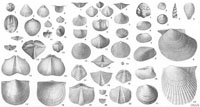2.12: Devonian Period (419 to 359 million years)
- Page ID
- 9780
Highlights of the Middle and Late Paleozoic Era
The Middle to Late Paleozoic Era is highlighted by the development of forest ecosystems and the development of vertebrate species on land, and rise of large fish in the oceans.
Devonian Period (419 to 359 million years)
On land, free-sporing vascular plants adapted and spread across the landscape, allowing the first forests to cover the continents. By the middle of the Devonian several groups of plants had evolved leaves and true roots, and by the end of the period the first seed-bearing plants appeared. Terrestrial arthropods began to flourish. In the marine world, early ray-finned and lobe-finned bony fish and sharks appear and flourish as revealed in the fossil record. The first coiled-shelled ammonoid mollusks appeared. Holdover families of marine invertebrates from earlier times persisted, including trilobites, brachiopods, cephalopods, and reef-forming tabulate and rugose corals flourished in shallow seas (Figure 2.30).
The current oil and gas boom in the United States is largely because of the fracking technologies used to extract petroleum from the tight (meaning low permeability), black shales associated with organic-rich muddy sediments deposited in inland seas of Devonian and Mississippian age. These black shales underlie large regions of the Appalachians, the Mid continent, and northern Great Plains regions in the United States. These deposits are part of the Kaskaskia Sequence (see Figure 2.13).

Figure 2.30. Devonian Period brachiopods and common fossils from Kentucky


